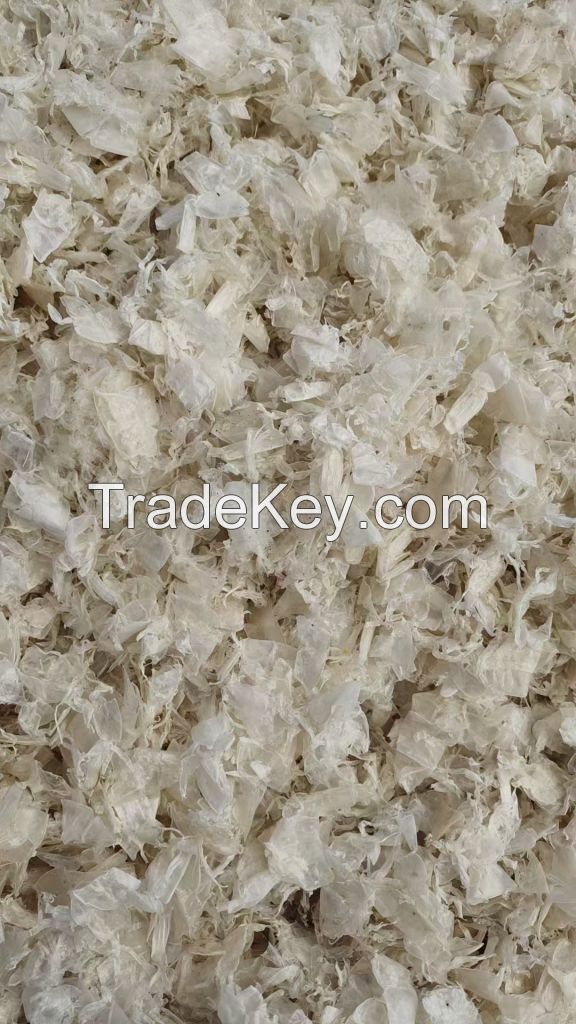Product Description
Chitin is a natural biopolymer widely found in fungi, arthropods,
mollusks and other organisms. It is composed of
N-acetylglucosamine and has important biological functions and
application values. The production process of chitin includes two
main links: biosynthesis and extraction. The biosynthesis process
is the process of chitin naturally forming in the body, while the
extraction process is to separate it from the organism containing
chitin.
Chinese scientists recently published their research results in
the journal Nature, revealing the complete process of chitin
biosynthesis. The study found that chitin synthase transfers the
sugar group on the donor substrate to the acceptor chitin sugar
chain, and the newly generated chitin sugar chain is released to
the outside of the cell through the transmembrane transport
channel on the cell membrane. Finally, the released chitin chain
spontaneously assembles into chitin nanofibers.
The product characteristics of chitin include its physicochemical
properties and biological activity. Chitin is usually expressed
in terms of its N-amino acetylation degree (DA) and the degree of
polymerization (DP) of the sugar unit structure to express its
chemical or physical characteristics. The larger the DA
value, the greater the percentage of acetylation of free amino
groups on the chitin skeleton; the larger the DP value, the
greater the chitin molecule is composed of more monosaccharide
molecules and the larger the molecular weight. Chitin is a white
amorphous substance, odorless and tasteless, soluble in
dimethylacetamide or concentrated hydrochloric acid containing 8%
lithium chloride, but insoluble in water, dilute acid, alkali,
ethanol or other organic solvents. Chitin and its derivatives
have a wide range of applications in medicine, chemical industry,
health food and other fields, such as additives for cosmetics and
functional foods, preparation of photographic emulsions, etc. In
addition, chitin synthase, as a molecular target for pesticides,
helps to create efficient, safe and eco-friendly pesticides,
which is of great significance to agricultural production.
几丁质又称几丁质或壳聚糖,是一种含氮多糖,广泛存在于甲壳类动物的外壳、昆虫的壳和真菌的细胞壁中。它有多种用途:
1、医药领域:几丁质可作为手术缝合线、伤口敷料、人造皮肤等医用材料,具有促进伤口愈合、抗肿瘤、调节免疫功能等作用。2
、食品工业:作为食品添加剂,几丁质有助于控制血糖、血脂水平,可延长食品的保质期。3
、工业应用:几丁质用于水和废水的净化,作为食品添加剂使食品稳定,在造纸工业中用于增加纸张强度。4
、化妆品:由于几丁质具有吸附、保湿等性能,可用于化妆品中。5
、农业:几丁质可诱导作物获得系统性疾病免疫力,产生几丁质酶等抗性物质,从而抵抗疾病。
6、环境保护:甲壳素及其衍生物对多种金属有螯合能力,在水净化、污水处理方面有应用前景。7
、生物技术:几丁质酶在医药、农业、食品加工等领域显示出巨大的市场潜力,如水解病原真菌的细胞壁,破坏害虫的体壁等。8、
纺织工业:甲壳素具有柔软、弹性、抗菌等特性,可作为内衣材料的添加剂。9、
造纸工业:作为造纸工业的添加剂,改善纸张的性能。*0
、照相工业:甲壳素用于制造耐磨、感光的照相材料。
甲壳素的这些应用,显示了它作为多功能天然高分子的潜力和重要性。
| Country: |
Indonesia |
| Model No: |
-
|
| FOB Price: |
4600 ~ 5500 / Tonne ( Negotiable ) (Negotiable)
Get Latest Price
|
| Place of Origin: |
cirebon indonesia |
| Price for Minimum Order: |
4600 per Tonne |
| Minimum Order Quantity: |
5 Tonne |
| Packaging Detail: |
Nylon woven cloth and nylon strapping, 100cm*80cm*45cm, 90-130kg/bag. |
| Delivery Time: |
20days |
| Supplying Ability: |
50 Tonne per Month |
| Payment Type: |
T/T |
| Product Group : |
- |

